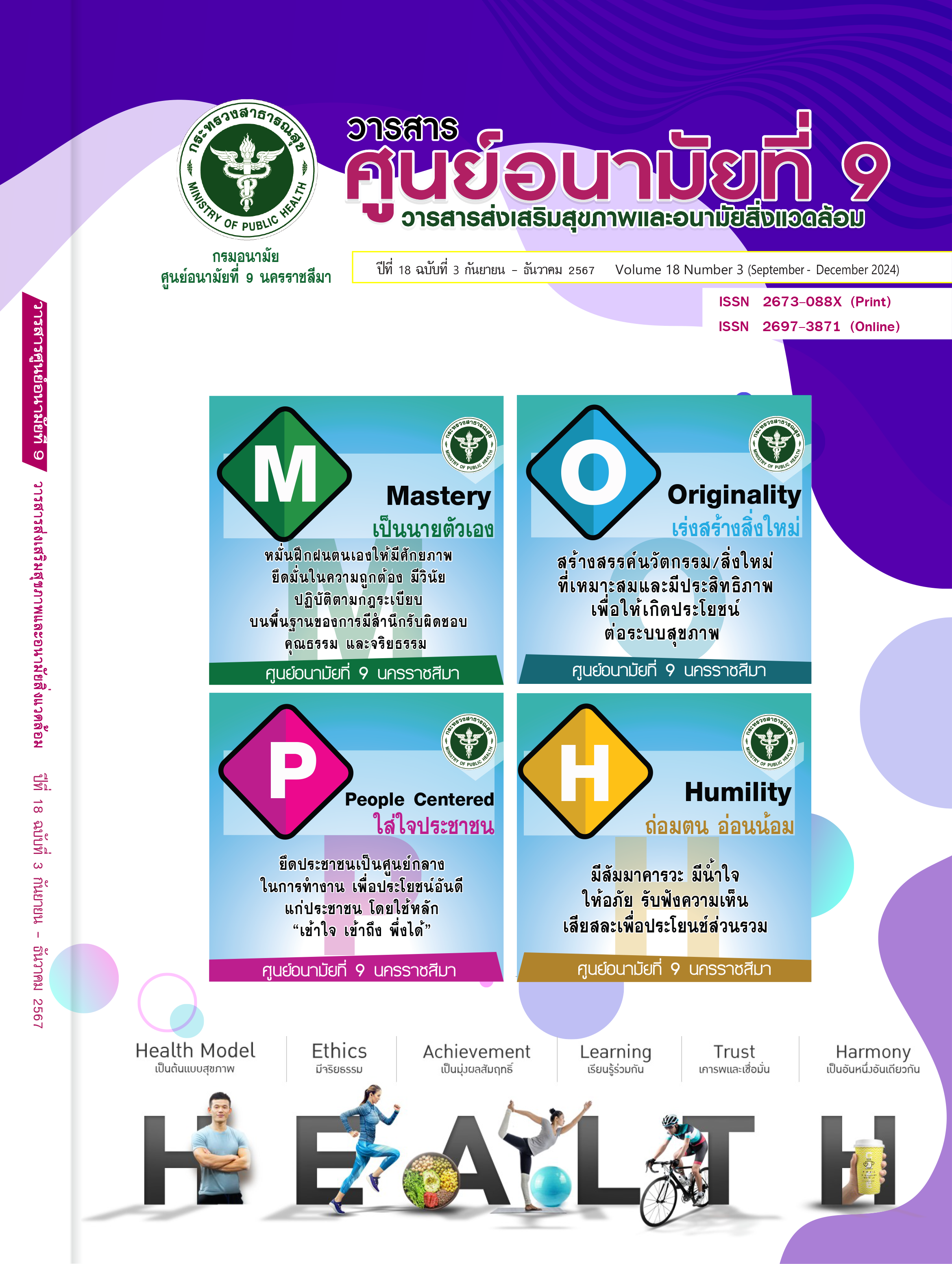ภาวะหมดไฟจากการทำงานและปัจจัยที่เกี่ยวข้องของบุคลากรด้านบริการปฐมภูมิ อำเภอพระนครศรีอยุธยา
คำสำคัญ:
ภาวะหมดไฟ, ปัจจัยที่เกี่ยวข้อง, บุคลากรปฐมภูมิบทคัดย่อ
ภาวะหมดไฟจากการทำงาน เป็นภาวะที่เกิดจากความเครียดเรื้อรังในสถานที่ทำงานที่ไม่สามารถจัดการได้อย่างสัมฤทธิ์ผล การศึกษาพรรณนาเชิงภาคตัดขวาง โดยแบบสอบถามออนไลน์ในบุคลากรด้านการบริการปฐมภูมิอำเภอพระนครศรีอยุธยาทุกตำแหน่งงาน เพื่อสำรวจความชุกของภาวะหมดไฟภาพรวมและแยกรายด้านในบุคลากรด้านบริการปฐมภูมิ อำเภอพระนครศรีอยุธยา และศึกษาปัจจัยที่สัมพันธ์กับภาวะหมดไฟ
บุคลากรตอบแบบสอบถามจำนวน 145 คน จาก 240 คน คิดเป็นร้อยละ 60.42 ความชุกภาวะหมดไฟภาพรวมร้อยละ 0.69 แยกรายด้าน ความชุกผู้ที่มีความอ่อนล้าทางอารมณ์ระดับสูง ร้อยละ 11.73 ความชุกผู้ที่มีการลดความเป็นบุคคลระดับสูงร้อยละ 9.65 ความชุกผู้ที่มีความสำเร็จ ส่วนบุคคลระดับต่ำร้อยละ 14.48 ปัจจัยที่สัมพันธ์กับความอ่อนล้าทางอารมณ์ระดับสูง ได้แก่ จำนวนบุคลากรเพียงพอกับงาน Adjusted OR 0.43 (0.19-0.97) และ มีอาการซึมเศร้าตั้งแต่ระดับน้อยขึ้นไป Adjusted OR 7.31 (1.45-36.73) ปัจจัยที่สัมพันธ์กับการลดความเป็นบุคคลระดับสูง ได้แก่ การใช้ยานอนหลับในช่วงสองสัปดาห์ที่ผ่านมา Adjusted OR 8.18 (1.96-34.25) และอาการซึมเศร้าตั้งแต่ระดับน้อยขึ้นไป Adjusted OR 4.11 (1.01-16.71) ปัจจัยที่สัมพันธ์กับความสำเร็จส่วนบุคคลระดับต่ำ ได้แก่ การศึกษาระดับปริญญาตรีขึ้นไป Adjusted OR 0.28 (0.79-0.97) ได้ไปเที่ยว Adjusted OR 0.21 (0.06-0.72)
ความชุกภาวะหมดไฟภาพรวมของบุคลากรปฐมภูมิอำเภอพระนครศรีอยุธยาระดับต่ำ ปัจจัยที่สัมพันธ์กับภาวะหมดไฟแยกรายด้าน ปัจจัยป้องกัน ได้แก่ ความรู้สึกบุคลากรเพียงพอกับงาน การศึกษาระดับปริญญาตรีขึ้นไป การได้ไปเที่ยว ปัจจัยเสี่ยง ได้แก่ มีอาการซึมเศร้าตั้งแต่ระดับน้อยขึ้นไป การใช้ยานอนหลับ
เอกสารอ้างอิง
Burnout. ICD-11 for Mortality and Morbidity Statistics [Internet]. 2023[cited 2023 Mar 30]. Available from: https://icd.who.int/browse11/l-m/en#/http://id.who.int/icd/entity/129180281
Maslach C, Schaufeli WB, Leiter MP. Job burnout. Annu Rev Psychol. 2001;52:397-422. doi: 10.1146/annurev.psych.52.1.397.
WHO. Primary care [Internet]. [cited 2023 Mar 1]. Available from: https://www.who.int/teams/integrated-health-services/clinical-services-and-systems/primary-care
Wright T, Mughal F, Babatunde OO, Dikomitis L, Mallen CD, Helliwell T. Burnout among primary health-care professionals in low- and middle-income countries: systematic review and meta-analysis. Bull World Health Organ. 2022 Jun 1;100(6):385-401A. doi: 10.2471/BLT.22.288300.
Auchayasawat S, Parichart Priamnong S, Praken T, Ritdejch N, Yingsanongchat P, Usaneengamcharoen P. Prevalence and Associated Factors of Burnout Syndrome among Clinical Medical Students, Ubon Ratchathani University. J Psychiatr Assoc Thailand. 2022;67(1):101-12.
Tuangpermsub R, Nuallaong W, Charernboon T. Burnout and Related Factor among Residents of Thammasat University Hospital In the COVID-19 Outbreak. J Psychiatr Assoc Thailand. 2021;66(2):189-202.
Thamrongvisava S, Pitanupong J. The Prevalence and Associated Factors of Burnout Syndrome among Residents in Training at Faculty of Medicine, Songklanagarind Hospital. J Psychiatr Assoc Thailand. 2018;63(4):309-20.
Srikam S, Jiamjarasrangsi W, Lalitanantpong D. Job Burnout and Related Factors among Residents of King Chulalongkorn Memorial Hospital. J Psychiatr Assoc Thailand. 2014; 59:139–50.
Runglirdsittikul K. Burnout and Associated Factors Among Healthcare Workers in Samutprakarn Hospital during the COVID-19 Pandemic. J Psychiatr Assoc Thailand. 2022;67(3):240-55.
Chutchaikulsiri P. Prevalence of Burnout Syndrome and Its Related Risk Factors among Healthcare Workers of Prasat Neurological Institute during Coronavirus (COVID-19) Pandemic. J Psychiatr Assoc Thailand. 2021;66(4):439-54.
Bumrungphanichthaworn T, Jaidee W, Wattanaburanon A, Maharachpong N. Factors Related to Burnout of Worker in Community Hospital on Pandemic COVID-19. The Public Health Journal of Burapha University. 2022;17(1):100-10.
Pensirinapa N. Burnout Syndrome among Health Personnel at Sub-District Health Promoting Hospitals in Nonthaburi Province during the Pandemic of COVID-19. Academic Journal of Community Public Health. 2023;9(1):84-96.
Yates SW. Physician Stress and Burnout. Am J Med. 2020 Feb;133(2):160-164. doi: 10.1016/j.amjmed.2019.08.034.
Shanafelt TD, Mungo M, Schmitgen J, Storz KA, Reeves D, Hayes SN, Sloan JA, Swensen SJ, Buskirk SJ. Longitudinal Study Evaluating the Association Between Physician Burnout and Changes in Professional Work Effort. Mayo Clin Proc. 2016 Apr;91(4):422-31. doi: 10.1016/j.mayocp.2016.02.001.
Oreskovich MR, Shanafelt T, Dyrbye LN, Tan L, Sotile W, Satele D, West CP, Sloan J, Boone S. The prevalence of substance use disorders in American physicians. Am J Addict. 2015 Jan;24(1):30-8. doi: 10.1111/ajad.12173.
Melamed S, Shirom A, Toker S, Berliner S, Shapira I. Burnout and risk of cardiovascular disease: evidence, possible causal paths, and promising research directions. Psychol Bull. 2006 May;132(3):327-53. doi: 10.1037/0033-2909.132.3.327.
Ryan E, Hore K, Power J, Jackson T. The relationship between physician burnout and depression, anxiety, suicidality and substance abuse: A mixed methods systematic review. Front Public Health. 2023 Mar 30;11:1133484. doi: 10.3389/fpubh.2023.1133484.
Maslach C, Leiter MP. Understanding the burnout experience: recent research and its implications for psychiatry. World Psychiatry. 2016 Jun;15(2):103-11. doi: 10.1002/wps.20311.
Wayne WD. Biostatistics: A foundation of analysis in the health sciences (6th ed.). Hoboken NJ: Wiley; 1998.
Research and Development Division, Mental Health Department, Mental Health Center 7, Khon Kaen. Burned out questionnaire for healthcare providers [Internet]. 2017 [cited 2023 Mar 1]. Available from: https://mhc7.dmh.go.th/wp-content/uploads/2017/09/แบบประเมินภาวะหมดไฟ-ฉบับเผยแพร่.pdf
Christina M, Jackson SE, Leiter MP, Schaufeli WB, Schwab RL. Maslach Burnout Inventory (2nd ed.). Palo Alto, CA: Consulting Psychologists Press; 1986.
Inkaw S, Phalitnonthakiat Y, Niemsaard S, Danwattana S, RQ: Resilience Quotient. Nonthaburi: The Bureau of the Mental Health Affair, MOPH; 2552: pp 63-7.
The Bureau of the Mental Health Affair. MOPH: Depression Screening form [Internet]. [cited 2023 Apr 4]. Available from: https://dmh.go.th/test/Download/view.asp?id=22
Weerametachai S. Prevalence and Factor Associated with Stress, Depression and Burnout among Healthcare Workers During 3rd Wave COVID 2019 Pandemic in Saraburi Hospital. Journal of Preventive Medicine Association of Thailand. 2022;12(1):65-81.
Reinhart E, Reely K, Dowdy K, Seth N, McGrade P, Jones C, et al. A systematic review of burnout and its relation to work-life balance and scheduling among United States physicians. The Southwest Respiratory and Critical Care Chronicles. 2020;8(34):40-6.
de Bloom J, Kompier M, Geurts S, de Weerth C, Taris T, Sonnentag S. Do we recover from vacation? Meta-analysis of vacation effects on health and well-being. J Occup Health. 2009;51(1):13-25. doi: 10.1539/joh.k8004.
ดาวน์โหลด
เผยแพร่แล้ว
รูปแบบการอ้างอิง
ฉบับ
ประเภทบทความ
สัญญาอนุญาต
ลิขสิทธิ์ (c) 2024 วารสารศูนย์อนามัยที่ 9 : วารสารส่งเสริมสุขภาพและอนามัยสิ่งแวดล้อม

อนุญาตภายใต้เงื่อนไข Creative Commons Attribution-NonCommercial-NoDerivatives 4.0 International License.
บทความหรือข้อคิดเห็นใด ๆ ที่ประกฎในวารสารศูนย์อนามัยที่ 9 เป็นความคิดเห็นของผู้เขียน บรรณาธิการ คณะผู้จัดทำ และศูนย์อนามัยที่ 9 นครราชสีมา (เจ้าของ) ไม่จำเป็นต้องเห็นด้วย ผู้เขียนต้องรับผิดชอบต่อบทความของตนเอง
ผลการพิจารณาของกองบรรณาธิการและผู้ทรงคุณวุฒิถือเป็นที่สิ้นสุด คณะบรรณาธิการวารสารฯ ขอสงวนสิทธิ์ในการตรวจแก้ไขข้อความให้ถูกต้องตามหลักภาษาและมีความเหมาะสม
กองบรรณาธิการวารสารฯ ขอสงวนสิทธิ์มิให้นำเนื้อหาใด ๆ ของบทความ หรือข้อคิดเห็นใด ๆ ของผลการประเมินบทความในวารสารฯ ไปเผยแพร่ก่อนได้รับอนุญาตจากกองบรรณาธิการ อย่างเป็นลายลักษณ์อักษร และผลงานที่ได้รับการตีพิมพ์ถือเป็นลิขสิทธิ์ของวารสารศูนย์อนามัยที่ 9


